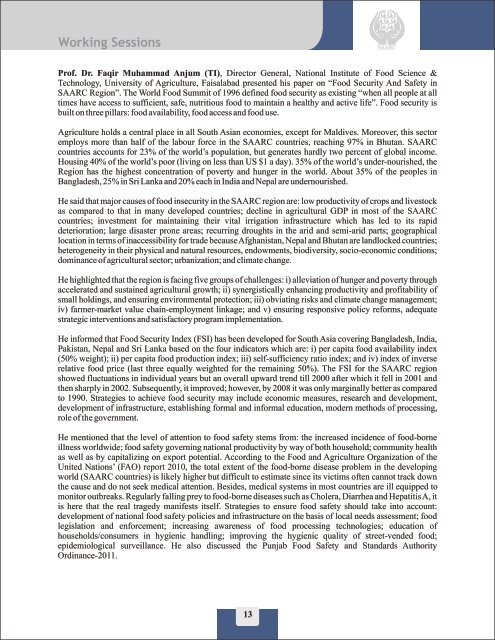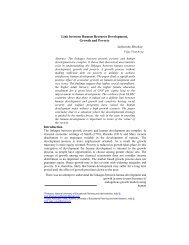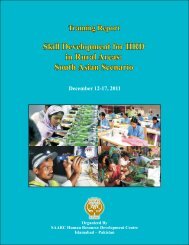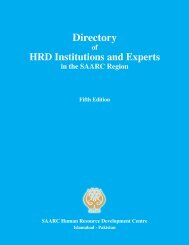Training Report: Millennium Development Goals in the SAARC Region
Training Report: Millennium Development Goals in the SAARC Region
Training Report: Millennium Development Goals in the SAARC Region
You also want an ePaper? Increase the reach of your titles
YUMPU automatically turns print PDFs into web optimized ePapers that Google loves.
Work<strong>in</strong>g Sessions<br />
Prof. Dr. Faqir Muhammad Anjum (TI), Director General, National Institute of Food Science &<br />
Technology, University of Agriculture, Faisalabad presented his paper on “Food Security And Safety <strong>in</strong><br />
<strong>SAARC</strong> <strong>Region</strong>”. The World Food Summit of 1996 def<strong>in</strong>ed food security as exist<strong>in</strong>g “when all people at all<br />
times have access to sufficient, safe, nutritious food to ma<strong>in</strong>ta<strong>in</strong> a healthy and active life”. Food security is<br />
built on three pillars: food availability, food access and food use.<br />
Agriculture holds a central place <strong>in</strong> all South Asian economies, except for Maldives. Moreover, this sector<br />
employs more than half of <strong>the</strong> labour force <strong>in</strong> <strong>the</strong> <strong>SAARC</strong> countries, reach<strong>in</strong>g 97% <strong>in</strong> Bhutan. <strong>SAARC</strong><br />
countries accounts for 23% of <strong>the</strong> world’s population, but generates hardly two percent of global <strong>in</strong>come.<br />
Hous<strong>in</strong>g 40% of <strong>the</strong> world’s poor (liv<strong>in</strong>g on less than US $1 a day). 35% of <strong>the</strong> world’s under-nourished, <strong>the</strong><br />
<strong>Region</strong> has <strong>the</strong> highest concentration of poverty and hunger <strong>in</strong> <strong>the</strong> world. About 35% of <strong>the</strong> peoples <strong>in</strong><br />
Bangladesh, 25% <strong>in</strong> Sri Lanka and 20% each <strong>in</strong> India and Nepal are undernourished.<br />
He said that major causes of food <strong>in</strong>security <strong>in</strong> <strong>the</strong> <strong>SAARC</strong> region are: low productivity of crops and livestock<br />
as compared to that <strong>in</strong> many developed countries; decl<strong>in</strong>e <strong>in</strong> agricultural GDP <strong>in</strong> most of <strong>the</strong> <strong>SAARC</strong><br />
countries; <strong>in</strong>vestment for ma<strong>in</strong>ta<strong>in</strong><strong>in</strong>g <strong>the</strong>ir vital irrigation <strong>in</strong>frastructure which has led to its rapid<br />
deterioration; large disaster prone areas; recurr<strong>in</strong>g droughts <strong>in</strong> <strong>the</strong> arid and semi-arid parts; geographical<br />
location <strong>in</strong> terms of <strong>in</strong>accessibility for trade because Afghanistan, Nepal and Bhutan are landlocked countries;<br />
heterogeneity <strong>in</strong> <strong>the</strong>ir physical and natural resources, endowments, biodiversity, socio-economic conditions;<br />
dom<strong>in</strong>ance of agricultural sector; urbanization; and climate change.<br />
He highlighted that <strong>the</strong> region is fac<strong>in</strong>g five groups of challenges: i) alleviation of hunger and poverty through<br />
accelerated and susta<strong>in</strong>ed agricultural growth; ii) synergistically enhanc<strong>in</strong>g productivity and profitability of<br />
small hold<strong>in</strong>gs, and ensur<strong>in</strong>g environmental protection; iii) obviat<strong>in</strong>g risks and climate change management;<br />
iv) farmer-market value cha<strong>in</strong>-employment l<strong>in</strong>kage; and v) ensur<strong>in</strong>g responsive policy reforms, adequate<br />
strategic <strong>in</strong>terventions and satisfactory program implementation.<br />
He <strong>in</strong>formed that Food Security Index (FSI) has been developed for South Asia cover<strong>in</strong>g Bangladesh, India,<br />
Pakistan, Nepal and Sri Lanka based on <strong>the</strong> four <strong>in</strong>dicators which are: i) per capita food availability <strong>in</strong>dex<br />
(50% weight); ii) per capita food production <strong>in</strong>dex; iii) self-sufficiency ratio <strong>in</strong>dex; and iv) <strong>in</strong>dex of <strong>in</strong>verse<br />
relative food price (last three equally weighted for <strong>the</strong> rema<strong>in</strong><strong>in</strong>g 50%). The FSI for <strong>the</strong> <strong>SAARC</strong> region<br />
showed fluctuations <strong>in</strong> <strong>in</strong>dividual years but an overall upward trend till 2000 after which it fell <strong>in</strong> 2001 and<br />
<strong>the</strong>n sharply <strong>in</strong> 2002. Subsequently, it improved; however, by 2008 it was only marg<strong>in</strong>ally better as compared<br />
to 1990. Strategies to achieve food security may <strong>in</strong>clude economic measures, research and development,<br />
development of <strong>in</strong>frastructure, establish<strong>in</strong>g formal and <strong>in</strong>formal education, modern methods of process<strong>in</strong>g,<br />
role of <strong>the</strong> government.<br />
He mentioned that <strong>the</strong> level of attention to food safety stems from: <strong>the</strong> <strong>in</strong>creased <strong>in</strong>cidence of food-borne<br />
illness worldwide; food safety govern<strong>in</strong>g national productivity by way of both household; community health<br />
as well as by capitaliz<strong>in</strong>g on export potential. Accord<strong>in</strong>g to <strong>the</strong> Food and Agriculture Organization of <strong>the</strong><br />
United Nations’ (FAO) report 2010, <strong>the</strong> total extent of <strong>the</strong> food-borne disease problem <strong>in</strong> <strong>the</strong> develop<strong>in</strong>g<br />
world (<strong>SAARC</strong> countries) is likely higher but difficult to estimate s<strong>in</strong>ce its victims often cannot track down<br />
<strong>the</strong> cause and do not seek medical attention. Besides, medical systems <strong>in</strong> most countries are ill equipped to<br />
monitor outbreaks. Regularly fall<strong>in</strong>g prey to food-borne diseases such as Cholera, Diarrhea and Hepatitis A, it<br />
is here that <strong>the</strong> real tragedy manifests itself. Strategies to ensure food safety should take <strong>in</strong>to account:<br />
development of national food safety policies and <strong>in</strong>frastructure on <strong>the</strong> basis of local needs assessment; food<br />
legislation and enforcement; <strong>in</strong>creas<strong>in</strong>g awareness of food process<strong>in</strong>g technologies; education of<br />
households/consumers <strong>in</strong> hygienic handl<strong>in</strong>g; improv<strong>in</strong>g <strong>the</strong> hygienic quality of street-vended food;<br />
epidemiological surveillance. He also discussed <strong>the</strong> Punjab Food Safety and Standards Authority<br />
Ord<strong>in</strong>ance-2011.<br />
13
















